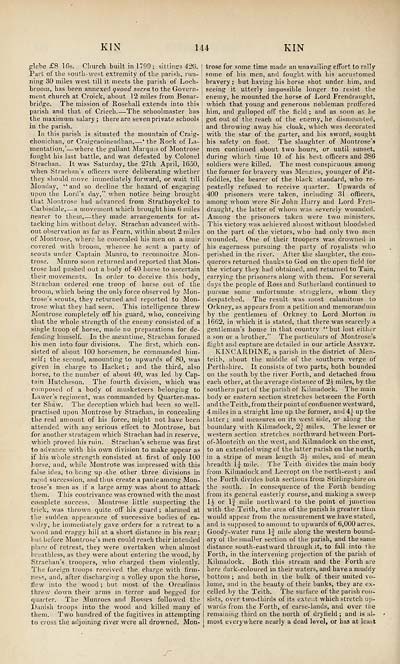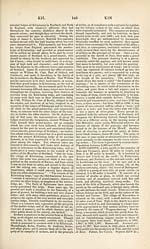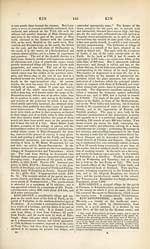Topographical, statistical, and historical gazetteer of Scotland > Volume 2
(156) Page 144
Download files
Complete book:
Individual page:
Thumbnail gallery: Grid view | List view

KIN
144
KIN
glebe £8 lfis. Church built in 1799; sittings 426.
Part of the south-west extremity of the parish, run-
ning 30 miles west till it meets the parish of Loch-
broom, has been annexed quoad sacra to the Govern-
ment church at Croick, about 12 miles from Bonar-
bridge. The mission of Rosehall extends into this
parish and that of Criech The schoolmaster has
the maximum salary; there are seven private schools
in the parish.
In this parish is situated tlie mountain of Craig-
chonichan, or Craigcaoineadhan, — 'the Rock of La-
mentation,' — where the gallant Marquis of Montrose
fought his last battle, and was defeated by Colonel
Strachan. It was Saturday, the 27th April, 1630,
when Strachan's officers were deliberating whether
they should move immediately forward, or wait till
Monday, "and so decline the hazard of engaging
upon the Lord's day," when notice being brought
that Montrose had advanced from Strathoyckel to
Caibisriale, — a movement which brought him 6 miles
nearer to them, — they made arrangements for at-
tacking him without delay. Strachan advanced with-
out observation as far as Fearn, within about 2 miles
of Montrose, where he concealed his men on a muir
covered with broom, whence he sent a party of
scouts under Captain Munro, to reconnoitre Mon-
trose. Munro soon returned and reported that Mon-
trose had pushed out a body of 40 horse to ascertain
their movements. In order to deceive this body,.
Strachan ordered one troop of horse out of the
broom, which being the only force observed by Mon-
trose's scouts, they returned and reported to Mon-
trose what they had seen. This intelligence threw
Montrose completely off his guard, who, conceiving
that the whole strength of the enemy consisted of a
single troop of horse, made no preparations for de-
fending himself. In the meantime, Strachan. formed
bis men into four divisions. The first, which con-
sisted of about 100 horsemen, he commanded him-
self; the second, amounting to upwards of SO, was
given in charge to Hacket ; and the third, also
horse, to the number of about 40. was led by Cap-
tain Huteheson. The fourth division, which was
composed of a body of musketeers belonging to
Lawer's regiment, was commanded by Quarter-mas-
ter Sbaw. The deception which had been so well-
practised upon Montrose by Strachan, in concealing
the real amount of his force, might not have been
attended with any serious effect to Montrose, but
for another stratagem which Strachan had in reserve,
which proved his ruin. Strachan's scheme was first
to advance with his own division to make appear as
if his whole strength consisted at first of only 100
horse, and, while Montrose was impressed with this
false idea, to bring up the other three divisions in
rapid succession, and thus create apanicamong Mon-
trose's men as if a large army was about to attack
them. This contrivance was crowned with the most
complete success. Montrose little suspecting the
trick, was thrown quite off his guard; alarmed at
the sudden appearance of successive bodies of ca-
valry, he immediately gave orders for a retreat to a
wood and craggy hill at a short distance in his rear;
bui. before Montrose's men could reach their intended
place of retreat, they were overtaken when almost
breathless, as they were about entering the wood, by
Strachan's troopers, who charged them violently.
The foreign troops received the charge with firm-
ness, and, after discharging a volley upon the horse,
flew into the wood ; but most of the Orcadians
threw down their arms in terror and begged for
quarter. The Munroes and Rosses followed the
Danish troops into the wood and killed many of
them. Two hundred of the fugitives in attempting
to cross the adjoining river were all drowned. Mon-
trose for some time made an unavailing effort to rally
some of bis men, and fought with his accustomed
bravery ; but having bis horse shot under him, and
seeing it utterly impossible longer to resist the
enemy, he mounted the horse of Lord Frendraught,
which that young and generous nobleman proffered
him, and galloped off the field ; and as soon as he
got out of the reach of the enemy, be dismounted,
and throwing away his cloak, which was decorated
with the star of the garter, and his sword, sought
his safety on foot. The slaughter of Montrose's
men continued about two hours, or until sunset,
during which time 10 of his best officers and 386
soldiers were killed. The most conspicuous among
the former for bravery was Menzies, younger of Pit-
foddles, the bearer of the black standard, who re-
peatedly refused to receive quarter. Upwards of
400 prisoners were taken, including 31 officers,
among whom were Sir John Hurry and Lord Fren-
draught, the latter of whom was severely wounded.
Among the prisoners taken were two ministers.
This victory was achieved almost without bloodshed
on the part of the victors, who had only two men
wounded. One of their troopers was drowned in
his eagerness pursuing the party of royalists who
perished in the river. After the slaughter, the con-
querors returned thanks to God on the open field tor
the victory they had obtained, and returned to Tain,
carrying the prisoners along with them. For several
days the people of Ross and Sutherland continued to
pursue some unfortunate stragglers, whom they
despatched. The result was most calamitous to
Orkney, as appears from a petition and memorandum
by the gentlemen of Orkney to Lord Morton m
1662, in which it is stated, that there was scarcely a
gentleman's house in that country "but lost either
a son or a brother." The particulars of Montrose's
flight and capture are detailed in our article Assynt.
KINCARDINE, a parish in the district of Men-
teith, about the middle of the southern verge of
Perthshire, It consists of two parts, both bounded
on the south by the river Forth, and detached from
each other, at. the average distance of 2^ miles, by the
southern part of the parish of Kilmadock. The main
body or eastern section stretches between the Forth
and theTeith, from their point of confluence westward,
4 miles in a straight line up the former, and 4.]- up the
latter ; and measures on its west side, or along the
boundary with Kilmadock, 2J miles. Tbe lesser or
western section stretches northward between Port-
of-Monteith on the west, and Kilmadock on the east,
to an extended wing of the latter parish on the north,
in a stripe of mean length 3^ miles, and of mean
breadth lj- mile. The Teith divides the main body
from Kilmadock and Lecropt on the north-east; and
the Forth divides both sections from Stirlingshire on
the south. In consequence of the Forth bending
from its general easterly course, and making a sweep
1£ or 1J mile northward to the point of junction
with the Teith, the area of the parish is greater than
would appear from the measurement we have stated,
and is supposed to amount to upwards of 6,000 acres.
Goody-water runs 1| mile along the western bound-
ary of the smaller section of the parish, and the same
distance south-eastward through it, to fall into the
Forth, in tbe intervening projection of the parish of
Kilmadock. Both this stream and the Forth are
here dark-coloured in their waters, and have a muddy
bottom ; and both in the bulk of their united vo-
lume, and in the beauty of their banks, they are ex-
celled by the Teith. The surface of the parish con-
sists, over two-thirds of its extent which stretch up-
wards from the Forth, of parse-lands, and over the
remaining third on the north of dryfield ; and is al-
most everywhere nearly a dead level, or has at least
r
144
KIN
glebe £8 lfis. Church built in 1799; sittings 426.
Part of the south-west extremity of the parish, run-
ning 30 miles west till it meets the parish of Loch-
broom, has been annexed quoad sacra to the Govern-
ment church at Croick, about 12 miles from Bonar-
bridge. The mission of Rosehall extends into this
parish and that of Criech The schoolmaster has
the maximum salary; there are seven private schools
in the parish.
In this parish is situated tlie mountain of Craig-
chonichan, or Craigcaoineadhan, — 'the Rock of La-
mentation,' — where the gallant Marquis of Montrose
fought his last battle, and was defeated by Colonel
Strachan. It was Saturday, the 27th April, 1630,
when Strachan's officers were deliberating whether
they should move immediately forward, or wait till
Monday, "and so decline the hazard of engaging
upon the Lord's day," when notice being brought
that Montrose had advanced from Strathoyckel to
Caibisriale, — a movement which brought him 6 miles
nearer to them, — they made arrangements for at-
tacking him without delay. Strachan advanced with-
out observation as far as Fearn, within about 2 miles
of Montrose, where he concealed his men on a muir
covered with broom, whence he sent a party of
scouts under Captain Munro, to reconnoitre Mon-
trose. Munro soon returned and reported that Mon-
trose had pushed out a body of 40 horse to ascertain
their movements. In order to deceive this body,.
Strachan ordered one troop of horse out of the
broom, which being the only force observed by Mon-
trose's scouts, they returned and reported to Mon-
trose what they had seen. This intelligence threw
Montrose completely off his guard, who, conceiving
that the whole strength of the enemy consisted of a
single troop of horse, made no preparations for de-
fending himself. In the meantime, Strachan. formed
bis men into four divisions. The first, which con-
sisted of about 100 horsemen, he commanded him-
self; the second, amounting to upwards of SO, was
given in charge to Hacket ; and the third, also
horse, to the number of about 40. was led by Cap-
tain Huteheson. The fourth division, which was
composed of a body of musketeers belonging to
Lawer's regiment, was commanded by Quarter-mas-
ter Sbaw. The deception which had been so well-
practised upon Montrose by Strachan, in concealing
the real amount of his force, might not have been
attended with any serious effect to Montrose, but
for another stratagem which Strachan had in reserve,
which proved his ruin. Strachan's scheme was first
to advance with his own division to make appear as
if his whole strength consisted at first of only 100
horse, and, while Montrose was impressed with this
false idea, to bring up the other three divisions in
rapid succession, and thus create apanicamong Mon-
trose's men as if a large army was about to attack
them. This contrivance was crowned with the most
complete success. Montrose little suspecting the
trick, was thrown quite off his guard; alarmed at
the sudden appearance of successive bodies of ca-
valry, he immediately gave orders for a retreat to a
wood and craggy hill at a short distance in his rear;
bui. before Montrose's men could reach their intended
place of retreat, they were overtaken when almost
breathless, as they were about entering the wood, by
Strachan's troopers, who charged them violently.
The foreign troops received the charge with firm-
ness, and, after discharging a volley upon the horse,
flew into the wood ; but most of the Orcadians
threw down their arms in terror and begged for
quarter. The Munroes and Rosses followed the
Danish troops into the wood and killed many of
them. Two hundred of the fugitives in attempting
to cross the adjoining river were all drowned. Mon-
trose for some time made an unavailing effort to rally
some of bis men, and fought with his accustomed
bravery ; but having bis horse shot under him, and
seeing it utterly impossible longer to resist the
enemy, he mounted the horse of Lord Frendraught,
which that young and generous nobleman proffered
him, and galloped off the field ; and as soon as he
got out of the reach of the enemy, be dismounted,
and throwing away his cloak, which was decorated
with the star of the garter, and his sword, sought
his safety on foot. The slaughter of Montrose's
men continued about two hours, or until sunset,
during which time 10 of his best officers and 386
soldiers were killed. The most conspicuous among
the former for bravery was Menzies, younger of Pit-
foddles, the bearer of the black standard, who re-
peatedly refused to receive quarter. Upwards of
400 prisoners were taken, including 31 officers,
among whom were Sir John Hurry and Lord Fren-
draught, the latter of whom was severely wounded.
Among the prisoners taken were two ministers.
This victory was achieved almost without bloodshed
on the part of the victors, who had only two men
wounded. One of their troopers was drowned in
his eagerness pursuing the party of royalists who
perished in the river. After the slaughter, the con-
querors returned thanks to God on the open field tor
the victory they had obtained, and returned to Tain,
carrying the prisoners along with them. For several
days the people of Ross and Sutherland continued to
pursue some unfortunate stragglers, whom they
despatched. The result was most calamitous to
Orkney, as appears from a petition and memorandum
by the gentlemen of Orkney to Lord Morton m
1662, in which it is stated, that there was scarcely a
gentleman's house in that country "but lost either
a son or a brother." The particulars of Montrose's
flight and capture are detailed in our article Assynt.
KINCARDINE, a parish in the district of Men-
teith, about the middle of the southern verge of
Perthshire, It consists of two parts, both bounded
on the south by the river Forth, and detached from
each other, at. the average distance of 2^ miles, by the
southern part of the parish of Kilmadock. The main
body or eastern section stretches between the Forth
and theTeith, from their point of confluence westward,
4 miles in a straight line up the former, and 4.]- up the
latter ; and measures on its west side, or along the
boundary with Kilmadock, 2J miles. Tbe lesser or
western section stretches northward between Port-
of-Monteith on the west, and Kilmadock on the east,
to an extended wing of the latter parish on the north,
in a stripe of mean length 3^ miles, and of mean
breadth lj- mile. The Teith divides the main body
from Kilmadock and Lecropt on the north-east; and
the Forth divides both sections from Stirlingshire on
the south. In consequence of the Forth bending
from its general easterly course, and making a sweep
1£ or 1J mile northward to the point of junction
with the Teith, the area of the parish is greater than
would appear from the measurement we have stated,
and is supposed to amount to upwards of 6,000 acres.
Goody-water runs 1| mile along the western bound-
ary of the smaller section of the parish, and the same
distance south-eastward through it, to fall into the
Forth, in tbe intervening projection of the parish of
Kilmadock. Both this stream and the Forth are
here dark-coloured in their waters, and have a muddy
bottom ; and both in the bulk of their united vo-
lume, and in the beauty of their banks, they are ex-
celled by the Teith. The surface of the parish con-
sists, over two-thirds of its extent which stretch up-
wards from the Forth, of parse-lands, and over the
remaining third on the north of dryfield ; and is al-
most everywhere nearly a dead level, or has at least
r
Set display mode to: Large image | Transcription
Images and transcriptions on this page, including medium image downloads, may be used under the Creative Commons Attribution 4.0 International Licence unless otherwise stated. ![]()
| Gazetteers of Scotland, 1803-1901 > Topographical, statistical, and historical gazetteer of Scotland > Volume 2 > (156) Page 144 |
|---|
| Permanent URL | https://digital.nls.uk/97495835 |
|---|
| Description | Volume second. I-Z. |
|---|---|
| Attribution and copyright: |
|

